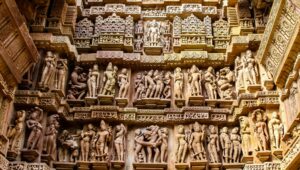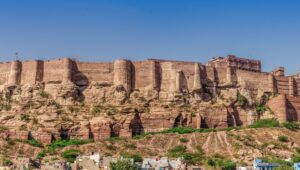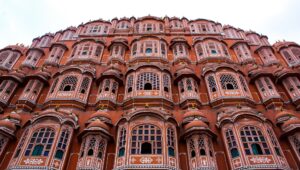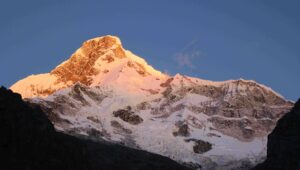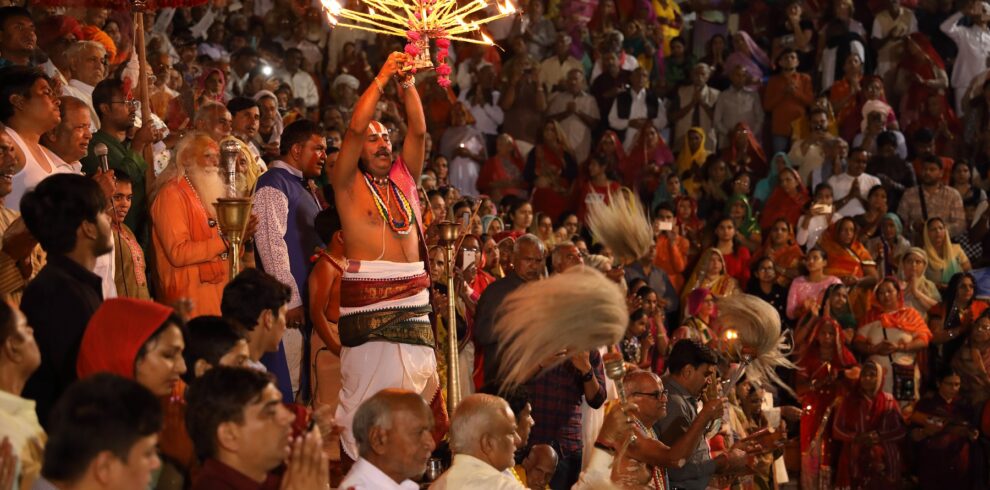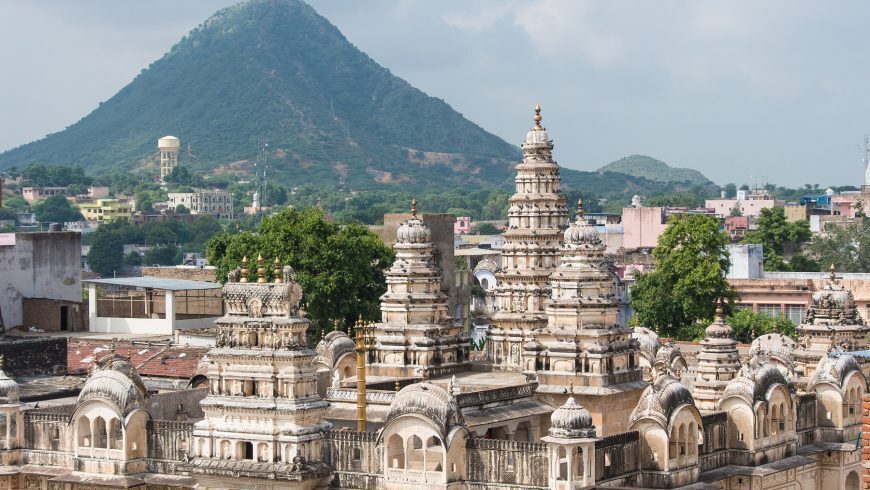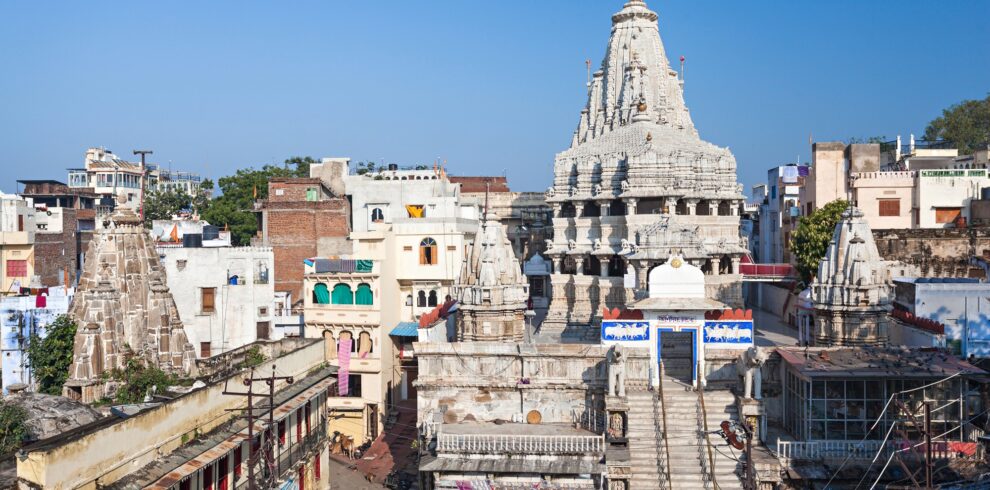Overview
Start an invigorating trip from Delhi, the capital of India, to explore the highlights of Delhi such as Jama Masjid and Red Fort. Experience some of the exciting offbeat locations in Rajasthan like Jodhpur, Ranakpur, Udaipur, Jaipur, and Pushkar. Head to Agra, which is home to the monument of love – the Taj Mahal. Visit Varanasi and discover the beauty of the several ghats beside the Ganges.
Highlights
- Explore the Red Fort, Jama Mosque, Chandni Chowk and India Gate
- Take in the majestic beauty of the Taj Mahal and the Agra Fort
- See the ecstatic Amber Fort and Fatehpur Sikri town
- Attend the sacred Ganga Aarti at Varanasi
- Offer your prayers at the Dhamek Stupa in Sarnath village
- Enjoy a boat ride by the banks of the famous River Ganga
Itinerary
Day 1 :
Arrive in Delhi
Arrive in Delhi, and transfer to the hotel.
Relax and enjoy personal activities.
Day 2 :
Delhi Sightseeing & Overnight Train for Jodhpur
Visit Red Fort - Shah Jahan constructed Red Fort in 1638. It was the main residence of the Mughal Dynasty and is located in the city center. It is made from red sandstone, and that is where it gets its name from. It became a UNESCO World Heritage Site in 2007.
Head to Qutub Minar, A five-story tapering tower with a height of 73 meters. The spiral staircase in this minaret has 379 staircases. It is a UNESCO World Heritage Site and is visited by many daily.
Stop by Lotus Temple, Famous for its flower-like shape; Lotus Temple is a house to worship and is open to all. Winning numerous awards, this place is a prominent attraction for all.
After sightseeing, drop at Delhi Railway Station.
Overnight journey in train for Jodhpur.
Day 3 :
Arrive at Jodhpur
In the morning, pick up from Jodhpur Railway Station and transfer to Jodhpur city hotel. After relaxing, enjoy the Jodhpur Sightseeing tour.
Go head to Mehrangarh Fort, A 5 km long majestic fort on a 125 m high hill that is one of the most impressive and formidable structures. Although invincible from the outside, the fort has four gates approached by winding roads. Within the fort are some magnificent palaces with marvellously carved panels, latticed windows, and evocative names.
Move to Jaswant Thada; the imposing white marble memorial marks the site of the royal crematorium. It houses portraits of successive rulers. The four cenotaphs around here commemorate notable acts of bravery and generosity of the four successive rulers.
Visit Umaid Bhawan Palace, A fabulous building which is split between the museum and a 5-star. The museum is interesting. Attached is a small collection of vintage cars which you can see.
Day 4 :
Jodhpur to Bishnoi Village Safari ( 80 KM/ 4 hrs).
In Morning time go to Bishnoi Village and take a safari, Its scenic beauty is marked by Khejri trees and the lake called Guda Bishnoi Lake. A place for exotic wildlife & nature. The Bishnoi community inhabits the village. The villagers are staunch worshipers of nature in all its forms, especially the sanctity of plants and animals' lives. We see numerous migratory birds around the Guda Bishnoi Lake like domicile Cranes, etc. blackbucks, and Chinkaras. This pond is a drinking point for antelope blackbuck nearby area. Khejarali is predominantly a village of the Bishnoi community people. In and around village Khejarli, where more than 363 Bishnois died, saving the Khejarli tree about two centuries ago.
Drive 3 km from here to Singasani village, a nice place to join the mud handicraft makers. After that, drop off at the pick-up point.
Finally, complete this half-day tour and have a Rajasthani lunch with locals.
Go to the Clock Tower, a popular landmark in the old city. The vibrant Sardar Market is close to the tower, and narrow alleys lead from here to a bazaar selling vegetables, spices, Indian sweets, textiles, silver, and handicrafts.
Day 5 :
Udaipur To Jodhpur (280 KM/ 5 Hrs) En route see the Ranakpur Jain Temple.
Drive to Ranakpur Jain Temple. The Ranakpur Temple complex comprises 1444 intricately carved pillars and 24 pillared halls accompanied by 80 domes which are borne by 400 columns. The apogee of this entire temple architecture is the fact that no two pillars here are the same. The temple structure has five spires, each of which houses a shrine underneath, and it is under the largest spire on the axis of the main entrance (Chaumukha Shrine) one can locate the 6 feet tall statue of Lord Adinath. Another exquisite aspect that has also earned the temple its name is the carving of the four-headed image of Adinath, sheltered by a 108-headed snake with numerous tails. The four heads face four directions, suggesting the pursuit of the Tirthankaras.
Visit Bagore Ki Haveli, and in the evening, watch the "Dharohar" folk dance show at Bagore-ki-Haveli. A gorgeous 18th-century haveli has been converted into a museum showcasing Mewar art and architecture. The haveli puts on one of the best Rajasthani folk dance shows in Rajasthan. For an hour, performers dance to Rajasthani folk music wearing bright-coloured ethnic dresses. The dances are varied and demonstrate the tradition and culture of Rajasthani folklore.
Day 6 :
Udaipur Sightseeing
Move to City Palace, A palace complex situated in the city of Udaipur. It was built over a period of nearly 400 years, with contributions from several rulers of the Mewar dynasty.
Visit Saheliyon Ki Bari, Which was laid for a group of forty-eight maidens. This garden is located on the banks of the Fateh Sagar Lake, presenting a green retreat in the drylands of Rajasthan. It was built from 1710 to 1734 by Maharana Sangram Singh for the royal ladies.
Go head to Jagdish Temple, A world-renowned temple of Lord Vishnu. This three stories and 79 feet high temple was built by Maharana Jagat Singhji in 1651 and cost 1.5 million rupees. It is owned and managed by the royal family of Udaipur.
See Dudh Talai, located on the banks of Lake Pichola near the City Palace.
Enjoy the beautiful view of Lake Pichola, Jagmandir Island Palace, Lake Palace, Udaivilas, The Leela Palace, gorgeous Aravalli ranges and Udaipur old city.
Day 7 :
Udaipur to Pushkar (270 KM/ 5 Hrs) En route see the Chittor Fort
In the early morning, leave Udaipur to visit Chittorgarh Fort, the largest fort in India. It is a UNESCO World Heritage site. The fort was the capital of Mewar and is located in the present-day town of Chittor. It sprawls over the hill 180 meters in height over an area of 280 ha (691.9 acres) above the plains of the valley drained by the Berach River. The fort has several historical palaces, gates, a temple and two prominent commemorative towers.
Then go head to Pushkar Lake. The creation of Pushkar Lake as an artificial lake is also credited to the 12th century when a dam was built across the headwaters of the Luni River. The 10th Sikh guru, Guru Govind Singh (1666–1708), is said to have recited the Sikh sacred text Guru Granth Sahib on the banks of the lake.
Day 8 :
Pushkar to Jaipur (130 KM/ 3 hrs)
Visit Ganahera Brahma Temple. Pushkar is best known for its Brahma temple.
Head to Chokhi Dhani.
Day 9 :
Jaipur Sightseeing
In the morning, visit Amber Fort, situated on the top of the hill. Amer Fort is located in Amer. It was built by Raja Man Singh I. It is known for its artistic elements. The Maota Lake located in front of the monument acts as a source of water for the fort.
Go Head to Jantar Mantar, A UNESCO World Heritage site built-in 1734. It is a collection of nineteen architectural astronomical instruments built by the Rajput king Sawai Jai Singh II, the founder of Jaipur. The instruments allow the observation of astronomical positions with the naked eye.
Move to City Palace and spend one-hour exploring Maharaja’s City Palace. The City Palace of Jaipur was originally the administrative and ceremonial seat of Maharaja of Jaipur, constructed in 1721. It was also the location of religious and cultural events that took place at that time. It now houses the Maharaja Sawai Man Singh II Museum and continues to be the home of the Jaipur royal family.
See Jal Mahal (6 km) on the way to Amer : This small palace is set in the middle of Man Sagar Lake. Renovation around the lake is in progress.
Stop by Hawa Mahal, also famous by the name "The Palace of Winds" or "The Palace of Breeze"). Built from red and pink sandstone, the palace sits on the edge of the City Palace, Jaipur, and extends to the Zenana, or women's chambers.
In the evening, free for leisure and marketing.
Day 10 :
Jaipur to Agra (240 KM/ 4 Hrs) En route see the Chand Baori & Fatehpur Sikri
Visit Chand Baori, built during the 8th and 9th centuries and has 3,500 narrow steps arranged in perfect symmetry, which descend 20m to the bottom of the well.
Go head to Fatehpur Sikri, a small city in northern India, just west of Agra, founded by a 16th-century Mughal emperor. Red sandstone buildings cluster at their center. Buland Darwaza gate is the entrance to Jama Masjid mosque. Nearby is the marble Tomb of Salim Chishti. Diwan-E-Khas hall has a carved central pillar. Jodha Bais Palace is a mix of Hindu and Mughal styles.
In the evening, visit the old Agra Market.
Day 11 :
Agra Sightseeing & Take a Varanasi Overnight Train
Visit the Taj Mahal, An ivory-white marble mausoleum on the southern bank of the river Yamuna in the Indian city of Agra. It was commissioned in 1632 by the Mughal emperor Shah Jahan to house the tomb of his favourite wife, Mumtaz Mahal: It also houses the tomb of Shah Jahan himself.
Then go to Agra Fort, A historical fort in the city of Agra in India. It was the main residence of the emperors of the Mughal Dynasty until 1638 when the capital was shifted from Agra to Delhi. Before it was captured by the British, the last Indian rulers to have occupied it were the Marathas.
Drop off at Agra Railway Station.
Day 12 :
Arrive at Varanasi
Drive 14 kilometres from the city center to Ramnagar Fort. The 18th-century sandstone fort and palace is no longer used as a defensive structure but instead houses a quirky museum brimming with vintage automobiles, elaborate hookahs, antique weapons, sedan chairs decked out in jewels, and a one-of-a-kind astronomical clock that's more than 150 years old.
See Dhamek Stupa, situated 12 kilometres away in the village of Sarnath. Here, find the Dhamek Stupa, a massive stone and brick structure that's 43.6 meters tall and 28 meters in diameter. The stupa was built more than 1,500 years ago as a replacement for a structure that dated back to 249 BCE.
Then go to Dasaswamedh Ghat, and experience the lively atmosphere of the Dasaswamedh Ghat.
Day 13 :
Varanasi Sightseeing
Visit Shri Kashi Vishwanath Temple : The impressive structure, dedicated to the Hindu deity Shiva, has earned the nickname "The Golden Temple" for its striking spire — plated in some 800 kilograms of pure gold. The distinctive design of this temple has gone on to inspire the architecture of hundreds of other temples across India.
Go head to Manikarnika Ghat, And see the perpetual cremations that happen on this ghat. Hindus believe that Manikarnika Ghat is one of the most auspicious places for the departed to reach moksha (emancipation from the cycle of spiritual rebirth). The funeral pyre at this ghat burns 24/7, and around 100 cremations take place every day.
Visit the Banaras Hindu University: It has been a central part of Varanasi's identity since its inception in 1916. The well-respected public university is home to more than 25,000 students, making it one of Asia's largest residential universities.
See Assi Ghat, The city's southernmost main ghat. Assi Ghat's star attraction is a Shiva lingam (phallic representation of the Hindu deity) beneath a sacred fig tree. It draws hundreds of pilgrims every day who come to worship Lord Shiva after rinsing in the Ganges River.
Watch the famous Ganga Aarti. Consider waking up early and taking a sunrise cruise along the river — negotiate with one of the countless boatmen hanging out along the ghats.
Day 14 :
Varanasi to Delhi
Pick up from Delhi Airport and start a Delhi sightseeing tour.
See one of the largest mosques in the country, Jama Masjid. It is made up of red sandstone and marble. It was constructed by Shah Jahan and is visited by hundreds of people daily. The mosque's courtyard can accommodate about 25,000 people and be built for about one million Indian Rupees.
Go head to Humayun's tomb, the tomb of the Mughal Emperor Humayun in Delhi, India. The tomb was commissioned by Humayun's first wife and chief consort, Empress Bega Begum, in 1558 and designed by Mirak Mirza Ghiyas and his son, Sayyid Muhammad; she chose Persian architects.
Then go to the Raj Ghat, a memorial dedicated to Mahatma Gandi; Raj Ghat is in Delhi. It is a black marble open to the sky, and a eternal flame burns at one end. It is a great place o learn more about the country's history.
Day 15 :
Delhi Departure with marking the end of this tour.
Visit the Connaught Place, a frenetic business and financial hub centred on a ring of collonaded Georgian-style buildings with global chain stores, vintage cinemas, bars, and Indian restaurants. Stalls at Janpath Market sell saris, embroidered bags, and trinkets. The peaceful Sikh temple Gurdwara Bangla Sahib is known for its reflecting pool, and Jantar Mantar is a 1700s observatory with huge astronomical.
Then go to Chandni Chowk, and take a Cycle Rickshaw ride in Chandni chowk & Khari Baoli Spice Market, a busy shopping area with markets full of spices, dried fruit, silver jewellery, and vivid saris. At the same time, the narrow side streets are crowded with tiny shops selling essential oils, stationery, and traditional Indian sweets.
In the evening, drop off at Delhi Airport or Delhi Railway Station, or any desired location in Delhi.
Trip ends
Include
- Private air-condition transport
- Bishnoi Village safari in Jodhpur
- Toll tax, Parking, fuel, etc
- Sightseeing
- Pick up and drop
- Hotel accommodation
- Delhi to Jodhpur train ticket
- Agra to Varanasi train ticket
Excludes
- Hotel is not included
- Lunch/Dinner
- Any type of monuments charges
- Any type of drinks charges
- Any type of personal expenses
- Varanasi to Delhi flight ticket






























